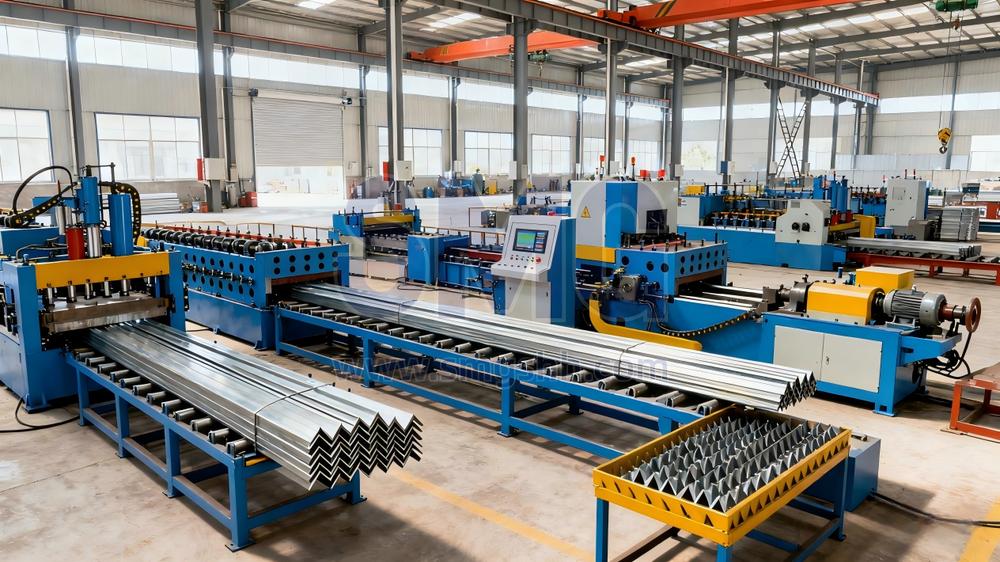
Date: 2025-10-16

Category: Metallurgical encyclopedia terms

Views: 103
Its core lies in completing the continuous production of processes from raw material feeding to punching, cutting, marking and other procedures through the collaborative operation of multiple special-purpose equipment, thereby significantly improving processing efficiency and processing precision.
The configuration of the angle steel production line is designed around the principles of "automation and continuity", and it usually consists of 4 core components, with all links connected seamlessly.
1.Feeding Unit: Responsible for automatically conveying bundled angle steel to the main processing line, eliminating the need for manual handling. It mainly includes a feeding rack and a feeding roller table; some production lines are equipped with a silo to realize unmanned material replenishment.
2.Processing Unit: The core of the production line, which centrally completes key processes such as punching, marking, and cutting. It is composed of equipment like CNC punching and marking machines and CNC cutting machines.
3.Conveying Unit: Connects various processing equipment and transfers angle steel between different processes via roller tables or manipulators, ensuring the production process is uninterrupted.
4.Unloading and Sorting Unit: The finished angle steel (after processing) is automatically conveyed to the unloading rack. Some high-end production lines are equipped with sorting mechanisms to stack the angle steel by specification or order.
The processing accuracy and efficiency of the production line are mainly determined by 3 types of key equipment, each with clear and complementary functions.
Core Functions: Simultaneously complete the punching and marking of angle steel (e.g., specifications, material, production date) without the need for secondary processing.
Key Features: Adopts a CNC system for positioning, with the punching position accuracy reaching ±0.1mm; supports multiple hole types (round holes, slotted holes); the marking content can be flexibly set via software.
Core Function: Based on the set length, it performs high-precision cutting on angle steel that has completed punching, and it serves as the "terminal processing equipment" of the production line.
Key Features: Adopts hydraulic or servo drive; the cutting surface is flat and burr-free; the length tolerance can be controlled within ±0.5mm; it supports batch automatic cutting without manual intervention.
Feeding Rack: Driven by hydraulic pressure or a motor, it lifts bundled angle steel layer by layer and feeds it into the feeding roller table, adapting to angle steel raw materials of different lengths (6-12m).
Unloading Rack: Receives the angle steel that has finished processing; some are equipped with buffer devices to prevent angle steel from being deformed due to collision, and at the same time, it facilitates subsequent manual or mechanical transfer.
The process of the angle steel production line follows the logic of "from rough to fine, continuous processing" and consists of 5 main steps, with the overall automation degree exceeding 90%.
1.Raw Material Preparation: Place bundled angle steel (usually plain carbon steel such as Q235) on the feeding rack, and manually complete initial straightening and rust removal (some production lines include a pre-treatment process).
2.Automatic Feeding and Conveying: The feeding rack sends the angle steel into the feeding roller table, and the roller table, driven by a servo motor, accurately conveys the angle steel to the CNC angle steel punching and marking machine.
3.Punching and Marking: According to preset parameters (hole position, hole type, marking content), the CNC system controls the punching die to complete punching; at the same time, the marking mechanism prints marks on the surface of the angle steel, and the two processes are completed simultaneously.
4.Precision Cutting: The angle steel that has completed punching is conveyed to the cutting machine. The cutting machine automatically cuts the angle steel according to the set length, and the cut angle steel directly enters the conveying roller table.
5.Unloading and Inspection: The finished angle steel (after processing) is conveyed to the unloading rack. Manual or automated equipment conducts random inspections on its appearance and dimensions. After passing the inspection, the angle steel is stacked by specification and awaits storage or subsequent assembly.


Phone



Address